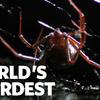6: Video, National Geographic’s “Deadly Mating.”
The description of the mother-figure in “Ummi Fi Shurl” hinges on her identification with a black widow spider. At first, the protagonist thinks she may have been bitten by a black widow spider, but in a darkly comic turn it appears that she’s been bitten by a human black widow, a bereaved woman wearing black. This joke runs much deeper than just linguistic confusion: black widow spiders are so named because they kill and eat their mates. In identifying the mother-figure with the black widow spider, the story creates a parallel between human familial relationships and the sometimes brutal, survival-of-the-fittest behaviors of the natural world.
Significantly, it is female black widow spiders who are dangerous: they not only are poisonous to humans and devour their male counterparts, but also, like all spiders, draw sustenance from cannibalizing insect prey. Female black widows are powerful and dominant, getting only what they need from their mates to perpetuate themselves. The black widow of “Ummi Fi Shurl” is also represented as dangerous, although she may represent a different type of danger, but a similar kind of power. There are no men present in the story, and other than the black widow’s dead husband, none are mentioned. It appears to be an entirely matrilineal world, where men are marginal and even unnecessary. It is women who go to work, reproduce, and raise children. At the same time, the relationship between these women seems precarious, even damaging, as with the initial sting.
Suggested Activity: Watch the video with students and read the part of the story in which the black widow character is described. Ask students: what does the description of the spider add to your understanding of the “black widow” character in “Ummi Fi Shurl”? Then ask them to think of other animals or natural phenomena that are often anthropomorphized or used to characterize human beings. For example, sometimes we call a tricky or slippery person a “snake.” Discuss: Why are nature metaphors so powerful? How do they enhance our understanding of people or fictional characters when used as descriptors?
Source: Nat Geo WILD, Deadly Mating | World’s Weirdest, National Geographic, Feb. 13 2013, video, 2:38, https://www.youtube.com/watch?time_continue=12&v=mRnCeg-EWio.

